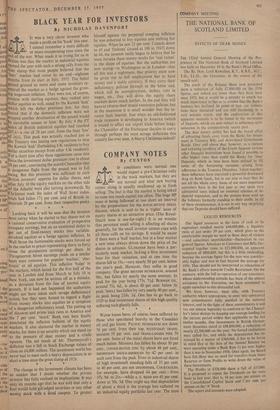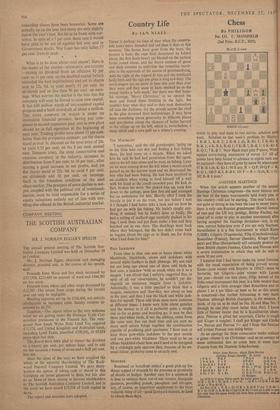COMPANY NOTES
By CUSTOS IF conditions were normal one would expect a pre-Christmas rally in the stock markets, but they are not normal and what new buying comes along is usually swallowed up in fresh selling. The fact is that the market is being asked to raise too much capital too often. The huge BP issue is being followed at too short an interval by the preparations for the ROYAL-DUTCH SHELL finance, which is said to be a 'rights' issue of equity shares at an attractive price. (The Royal- Dutch issue is one-for-eight.) It is no wonder that persistent small selling is affecting oil shares generally, for the small investor cannot cope with all these calls on his savings. It would be easier if there were a 'bull' market, but in a bear market a new issue always drives down the price of the shares in advance. ULTRAMAR have been a par- ticularly weak market, lacking a firm investment base for their valuation, and at one time the shares fell to 55s.—very nearly 50 per cent. below the year's peak. However, they suffer in good company. The great BRITISH PETROLEUM, around 90s., has fallen by nearly the same amount, its peak for the year being 173s. 71d. Bliamm
around 71s. 6d., is about 40 per cent. below its peak. SHELL has fallen by very nearly 40 per cent., its peak being 218s. 3d. One has to go back to 1929 to find investment shares of this high quality suffering such ghastly falls. * * *
Worse losses have, of course, been suffered by those who speculated heavily in the Canadian oil and gas boom. PACIFIC PETROLEUM are down 56 per cent. from their top, WESTCOAST TRANS- MISSION 55 per cent. and TRANS-CANADA PIPE 59 per cent. Some of the metal shares have not fared much better. MESSINA has fallen by about 50 per cent., CONSOLIDATED ZINC by about 48 pet cent., RHODESIAN ANGLO-AMERICAN by 42 per cent. in each case from the peak. Even in industrial shares of high investment standing falls of 35 per cent. to 40 per cent. are not uncommon. COURTAULDS, for example, have dropped 44 per cent.—from 37s. 9d. to 21s.—while A. E. REED are 45 per cent. down at 30s. 3d. One might say that depreciation of about a third is the average loss suffered on an industrial equity portfolio last year. The most
rewarding shares have been breweries. Some are actually up on the year and many are only slightly below the year's best. But let us be frank with our- selves. In spite of a 7 per cent. Bank rate it would have paid to be out of equities last year and in Government stocks. War Loan has only fallen 17 per cent. from its peak.
What is to be done about steel shares? Here is the leader of the market—STEWARTS AND LLOYDS —raising its dividend from an effective 8 per cent. to l I per cent. on the doubled capital (which exceeded the best expectations) and yet its shares sink to 22s. 9d. to yield nearly 9:1- per cent. on dividends and no less than 50 per cent. on earn- ings. What worries the market is the hint that the company will soon be forced to raise new capital. It has £40 million worth of uncompleted capital projects and a bank overdraft of about a million.
THE STEEL COMPANY OF WALES is under no immediate financial pressure, having just com- pleted its second expansion plan, and its new plant should be in full operation at the beginning of next year. Trading profits were about 15 per cent. better than the prospectus estimate; yet the shares stand at over 3s. discount on the issue price of 20s. to yield 9.35 per cent. on the 8 per cent. annual rate. DORMAN LONG, the most conservative and cautious company in the industry, increases its distribution from 8 per cent. to 10 per cent., after scoring a good increase in net profits, and yet the shares stand at 22s. 9d. to yield 9 per cent. on dividends and 36 per cent. on earnings. Such is the friendless condition of the steel share market. The prospect of some decline in out- put, coupled with the political risk of renational- isation, must be held responsible for a series of equity valuations entirely out of line with any- thing else offered in the British industrial market.



























 Previous page
Previous page